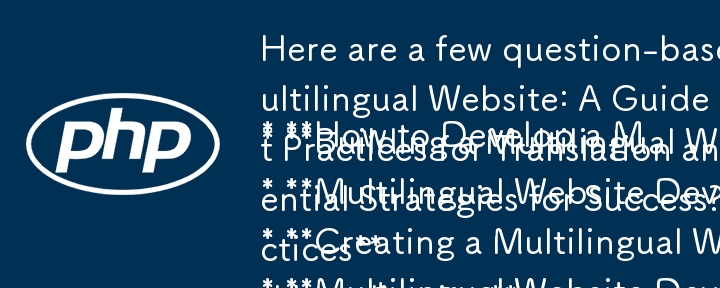Home > Article > Backend Development > Here are a few question-based titles that capture the essence of your article: * **How to Develop a Multilingual Website: A Guide to Best Practices** * **Building a Multilingual Website: What Are the
Here are a few question-based titles that capture the essence of your article: * **How to Develop a Multilingual Website: A Guide to Best Practices** * **Building a Multilingual Website: What Are the
- Susan SarandonOriginal
- 2024-10-25 07:24:29434browse

Best Practice for Multilingual Website Development
Introduction
Creating a multilingual website requires meticulous planning and implementation. This guide explores best practices for various aspects of multilingual websites, including translation management, URL routing, and localization.
Translation Management
Database-Driven Storage: Store translations in a database table that includes fields for language code, table name, primary key, and translation value. This centralizes translations and facilitates efficient maintenance.
Template-Based Rendering: Use templates to separate content from presentation. Templates can be rendered with the translated values selected from the database based on the current language. This allows for dynamic content updates without modifying HTML files.
Caching and Performance: Implement a caching mechanism to improve response times. Store pre-rendered language files in the file system, organized by language and content type. This reduces database load and enhances user experience.
URL Routing
Query-Based Routing: Use query parameters to determine both language and content. This approach relies on content segments to convey language information, supplemented by language selection from cookies or headers.
Language-Prefixed Routing: Include the language prefix in the URL to explicitly specify the language. This simplifies language identification, removes ambiguity, and allows for cleaner URLs.
Combining Approaches: Consider using a hybrid approach where the default language removes the language prefix in the URL, while sublanguages use a translated SEO slug with language prefix.
Content Translation
Dynamic Content Management: Enable content editors to create and manage translations within the CMS. The translation process should be user-friendly and integrated into the editorial workflow.
Fallbacks and Defaults: Implement a fallback mechanism to display untranslated content in the default language when translations are unavailable. To ensure content integrity, automatically insert missing translations or regenerate the translation file.
Localization Considerations
Date and Time: Use the PHP intl extension to handle internationalization issues related to date and time formats, ensuring accurate representation across languages and cultures.
Conclusion
Creating a multilingual website involves balancing efficiency, flexibility, and user experience. By implementing best practices in translation management, URL routing, content translation, and localization, developers can create multilingual websites that are accessible, informative, and engaging for users from all over the world.
The above is the detailed content of Here are a few question-based titles that capture the essence of your article: * **How to Develop a Multilingual Website: A Guide to Best Practices** * **Building a Multilingual Website: What Are the. For more information, please follow other related articles on the PHP Chinese website!